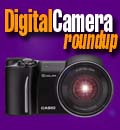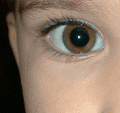|
Olympus E-620 with PT-E06 Underwater Housing
All-purpose digital SLR with live view LCD and professional quality underwater housing system
(by Conrad H. Blickenstorfer and Carol Cotton)
The 12.3 megapixel Olympus E-620, which bridged the gap between the US$499 Olympus E-520 and the US$999 E-30, was introduced in February of 2009. Compared to its predecessors, it demonstrated the digital imaging industry's effort to make digital SLR cameras smaller, lighter and more advanced while at the same time adding the kinds of entertaining and useful features and functions that up to now have primarily been available in consumer point-and-shoot cameras.
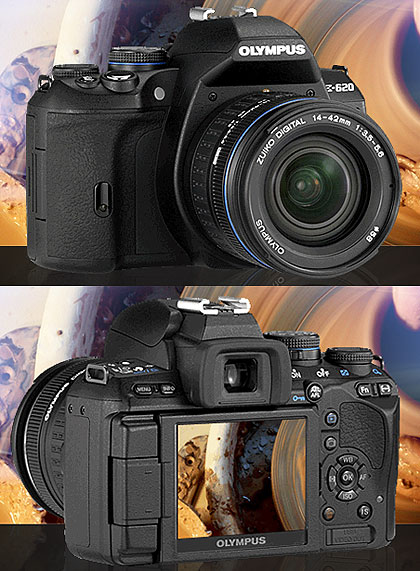
Perhaps as a sign of the times where more and more former point & shoot photographers are getting their first dSLR, Olympus concentrated on art filters and other onboard features in its press release intro as opposed to the cool new technology that attracted our attention.
Explaining the thought process behind adding a variety of fun things to the E-620, Olympus pointed out how children are encouraged to express their imaginations and how we proudly display their finger-painted artistic creations on refrigerators. As people grow older, Olympus said, they are taught to color inside the lines, so to speak, and we spend less time on art and eventually may lose touch with the satisfaction that comes from creating something unique. With the new E-620, Olympus wants to bring back the ability to experiment and enjoy the wondrous feeling of being inspired by our own art.
To that extent, the camera has a number of artistic filters and multiple exposure features built right into the camera. That can be fun for experts and beginners alike, and it allows the creation of interesting images without using a computer and editing software (though we'd generally expect folks who use dSLRs to do such things with their own image manipulation software).
The 12.3 megapixel E-620's other claim to fame is its compact size and light body that weighs only a pound. According to Olympus, the E-620 is also the world's smallest DSLR with in-body Image stabilization that works with any lens. There's also Live View shooting, first introduced with the Evolt-330, with a nicely sized swivel 2.7-inch LCD that lets you shoot subjects from a range of angles.
The "Four Thirds" system
What you get with the E-620 is a full-function digital single lens reflex camera that uses the Four Thirds Mount System developed by Olympus and Kodak specifically for digital SLRs and used by several other camera companies. A word about the Four Thirds system: The name �Four Thirds� comes from the 4:3 aspect ratio of the sensor. That's different from the 3:2 aspect ratio used in the old 35mm film, but the same as that in traditional, and by now old-style, computer monitors and TVs. The sensor used in Four Thirds systems measures 18 x 13.5 millimeters as opposed to the traditional 36 x 24mm film �sensor� area and the much smaller sensors of compact digital cameras. This allows for more compact lenses suitable for digital SLRS that can also be more compact than traditional film SLRs. To learn more about the Four Thirds system, check its official website at http://www.four-thirds.org/en/index.html. Note that "Four Thirds" doesn't mean that the E-620 can only shoot in 4:3 aspect ratio. In fact, you can set it to 4:3, 3:2, 16:9 or 6:6.
Digital SLRS getting smaller and lighter
Like most SLRs, even most digital ones, the E-620 is large but, and that is important, not quite as large as its predecessors. It is a camera in the traditional sense of the word, not one of those 12-megapixel ultra-slim techno-slivers that you stick into any pocket. And the size also depends on the lens. The bare camera body, sans lens, measures 5.1 x 3.7 x 2.4 inches and weighs about 16 ounces without battery or cards. That means the volume is down about 15% and weight almost 20% compared to Olympus Evolt E-330, and we can attest that this makes a very considerable difference in day-to-day use of the camera. It's still a substantial camera, of course, but that is the price you pay for the generally superior performance of a digital SLR compared to even a very good compact.
"Live-View" on a terrific LCD
As big fans of the Olympus Evolt E-330, we found much to like about the E-620. It starts with something Olympus introduced with the E-330, the Live-View LCD. Traditionally, SLRs used a through-the-lens viewfinder that presents a totally accurate view of what the picture will look like. That's great, but it also means you need to look through it when you take a picture. Not very inconspicuous. So, in addition to the optical viewfinder, the E-620 has a live-view LCD. How much of an advantage is this? So much that a friend and owner of a three-year-old Canon dSLR that did not have live-view wanted to instantly replace her camera with an E-620.
And the LCD is not a fixed one either. With the older E-330 you could pull the LCD out and then rotate it so that you could hold the camera at hip level and look down onto the LCD, or you could hold the
camera above your head to shoot over the heads of a crowd and you could still see the downward-tilted LCD. With the E-620, the LCD is hinged on the side so that you can fold it open all the way to 180 degrees. You can then also rotate the LCD by a full 270 degrees. This gives you unprecedented freedom in taking pictures not only from hip level and above your head, but also sideways or even looking at the camera.
Below you can see how the E-620's extremely versatile fold-out LCD system (left) looks like compared to the older setup on the E-330 (right).
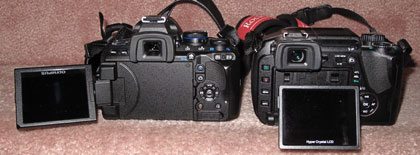
The 2.7-inch diagonal LCD is also large enough to see what's going on and its 230,000 pixel resolution means you can zoom in (up to 14X in six steps) and get a very good feel for whether the picture is sharp or not. The LCD uses Olympus' HyperCrystal technology that makes for a vibrant display, and the LCD has a very wide viewing angle from all sides. Olympus claims 160 degrees, but it's really more like a full 180.
Two card slots
There are other goodies. For example, in the past we often criticized Olympus for its use of the xD-Picture card that generally costs a bit more and is increasingly more difficult to find than the popular SD Card and older CF card formats. Well, like the E-330, the E-620 has both an xD-Picture card slot and a CF Card slot, so you can use either format or both. You can also copy from one to the other, which comes in handy if your computer can read CF cards but not xD cards.
Dust reduction technology
Another cool technology you find in the E-620 is its Dust Reduction System that vibrates dust right off the sensitive space between the shutter and the image sensor. Why do you need it? Because dust and other particles have always been the bane of SLR cameras where the mirror is exposed when you exchange lenses. That can result in specks and artifacts on the picture.
TruePic processor
And there's more high technology in the form of the Olympus TruePic III+ Image Processor that uses all the pixel information to optimize each image (with, according to Olympus, special attention to accurate natural color, true-to-life flesh tones, brilliant blue skies, and precise tonal expression) and also lowers image noise in photos shot at higher ISO settings, enabling great results in low-light situations. It's hard to quantify the benefit of all the electronics and special chips in today's cameras, but we certainly can't argue with the results. The E-620 delivered consistently excellent pictures.
Art filters
Applying playful filters has not traditionally been high on the list of digital SLR photographers, but with electronics making a huge range of new features and processing inside the camera possible, a bit of exploration is a good thing. To that extent, Olympus added a number of "art filters" to the camera with the goal of providing individual artistic control over an image. The filters are:
- Pop Art to enhances colors, making them more saturated and vivid, creating high-impact pictures that express the joyful, lighthearted feeling of the Pop Art style of the 1960s
- Soft Focus to create an ethereal, otherworldly atmosphere that renders subjects in a heavenly light without obscuring details
- Pale & Light Color to enclose the foreground of an image in flat gentle light and pastel colors reminiscent of a flashback scene in a movie
- Light Tone to render shade and highlight areas softly to lend an elegant air to the subject
- Grainy Film to evoke the feeling of documentary footage shot in monochrome with grainy, high-contrast film, and
- Pin Hole to reduce the peripheral brightness of an image as though it were shot through a pin hole, connecting the viewer intimately with the subject at the center of the picture.
Needless to say, all of this can also be done in imaging software, but there's nothing wrong with exploring new boundaries and ways of manipulating images right in our increasingly more powerful cameras.
Multiple exposure shooting
The E-620 has a Multiple Exposure function that can be used to tell a visual story in a portrait, a landscape or a combination of both. The image capture options lets you either shoot in sequence or capture separate images and combine them in the camera later.
In-Body image stabilization
The E-620 has in-body Image Stabilization that can virtually eliminate blur with any lens attached. There are three image stabilization modes to cover any situation where blur might happen. The IS-1 mode adjusts the sensor on both the horizontal and vertical planes to compensate for movement by the photographer so images stay sharp in low light even at slow shutter speeds. This works for most general shooting situations. The IS-2 mode is for capturing subjects traveling by horizontally and preserves the sense of motion while panning. The IS-3 mode produces the same effect when the camera is held vertically.
Dual autofocus systems
Just like the E-620 offers two different ways to viewing (LCD and optical viewfinder), it also has two autofocus options. Fast Imager Autofocus in Live View lets you to compose, focus, and capture a shot without ever taking your eye off the LCD, just like with a point & shooter. Phase Detection AF is used with the optical viewfinder and the technology behind the new 7-point twin cross AF system provides super-fast and accurate focusing based on the speed of the advanced Olympus E-3. Extremely sensitive Twin and Twin Cross AF target points can measure focus both vertically and horizontally, so regardless of the subject, focusing is fast and simple, even when shooting moving subjects.
Shooting with different aspect ratios
These days we're used to a variety of different aspect ratios in movies, HDTV, video and pictures. The E-620 lets you shoot in the standard 4:3 aspect ratio that is perfectly suited for 8 x 10-inch enlargements; the 16:9 aspect ratio that's perfect on a widescreen television; and other popular aspect ratios such as 3:2 and 6:6. Select the desired aspect ratio before shooting so you can view it on the LCD throughout the shoot for optimal framing.
Face detection
Increasingly sophisticated face detection has become a standard feature in almost all consumer cameras, and is now becoming popular in dSLRs as well. The E-620 tracks up to eight faces within the image area, even if people are moving, and automatically focuses and optimizes exposure for sharp and optimally exposed portrait pictures. This is basic by compact standards, but still welcome.
Shadow adjustment technology
Shooting scenes with both highlights and shadows can be tricky because of the extreme contrast between dark and bright. The E-620 uses Shadow Adjustment Technology that adjusts for extreme light variations and maintains visible detail in both the shadow and highlight areas of the scene. You can actually see and preview the gradation on the Live View LCD before capturing an image. This feature is also accessible in the Edit menu after the shot has been taken.
Alternate picture effect preview
Perfect Shot Preview lets you preview and select from a variety of thumbnail previews of the photographic effects of white balance and exposure compensation adjustments live on the LCD before actually taking the picture. This is helpful when first learning about the effects of different techniques without having to scroll through a long menu.
Wireless flash capability
There are many situations that require multiple flashes, and this is often best achieved with wireless flashes. The E-620 is compatible with the Olympus FL-36R and FL-50R wireless electronic flashes designed exclusively for digital photography. The E-620 can control up to three wireless flash groups independently, with multiple flash units in each group for dramatic flash effects.
Optional underwater housing
Olympus has a proud history of underwater photography and offers the PT-E06 optional underwater housing for the E-620. The PT-E06 can handle depths of 130 feet underwater.
Easy to use, with some caveats
SLRs, in general, are still needlessly complicated to use and do not have the almost total standardization of controls that compacts have. Instead, there are buttons, levers and controls all over the place. The E-620 is no exception, and so a few hours' worth of reading, studying and practicing is absolutely mandatory before the first serious photo outing.
As is the case with many dSLRs, the interface and menus are a mess. There is a Menu button that brings up vertically tabbed walking menus. They still use that befuddling mix of text (ALL UPPER CASE), icons and illustrations that camera makers the world over employ to confuse users. We already noted with the Olympus E-330 that it is very cumbersome to have to memorize dozens of funky icons and pictograms when the screens are now large enough and have high enough resolutions to simply spell things out. That gibberish is bad enough on menus where there is always a shortage of real estate, but it is downright inexcusable with things like exposure metering where there's plenty of space to describe those often unintelligible icons. In the era of the iPhone with its beautiful and eminently functional user interface, the gnarly old interface mess on digital camera menus is less and less acceptable. It's almost as if a bunch of old-school photographers deliberately made the camera difficult to use with the gaggle of buttons and levers from before the digital era.
This whole mess, unfortunately, means that a lot of the power of this remarkable camera will go unused and the camera will simply be left in Program mode which, fortunately, usually results in great shots anyway. More advanced photographers, and those willing to learn how to use the interface, will find plenty of options to set up great shots and go for special effects.
A word of caution to beginning photographers who expect a digital SLR to be able to do it all. It's not so. Despite their size and sophistication, most current dSLRS, including the E-620 don't do such mundane things as shooting movies or recording sound.
Assorted specs we like
In terms of specifications, here are some of the ones that matter: You can record as JPEG, TIFF or RAW. When shooting in RAW, you can also save a JPEG image in addition. Exposure compensation is not fixed, but can go in 0.3 EV step increments from plus 5EV to minus 5EV. Shutter speed ranges all the way from 1/4000 of a second to a full eight minutes in bulb mode. Sequential shooting yields about three frames per second. There's a built-in flash in addition to a hot shoe for a (recommended) external flash. The 7.2 Volt, 1,800mAH Li-Ion rechargeable battery, despite being significantly smaller than the massive E-330 powerpack, is actually more powerful. You can do exposure bracketing and have great influence over color settings: color space, picture mode, sharpness, contrast, saturation, filters, toning and gradation. It all adds up to remarkable flexibility.
Underwater shooting
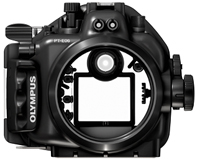 As mentioned above, we shot many more pictures underwater than above with the E-620. That requires the PT-E06 Underwater Housing shown to the left (without the exernal flash housing we also used). It is a durable, very high quality polycarbonate housing specifically designed for the E-620 and allows you to take the camera down to about 130 feet, which is the recreational scuba diving limit. Interestingly, the 130 limit of the PT-E06 is considerably less than the 200 feet limit of the (less expensive) PT-E02 housing we used in the older Evolt E-330. Unlike the E-330's housing that was all clear, the entire main body of the PT-E06 housing is black and only the back is clear. As mentioned above, we shot many more pictures underwater than above with the E-620. That requires the PT-E06 Underwater Housing shown to the left (without the exernal flash housing we also used). It is a durable, very high quality polycarbonate housing specifically designed for the E-620 and allows you to take the camera down to about 130 feet, which is the recreational scuba diving limit. Interestingly, the 130 limit of the PT-E06 is considerably less than the 200 feet limit of the (less expensive) PT-E02 housing we used in the older Evolt E-330. Unlike the E-330's housing that was all clear, the entire main body of the PT-E06 housing is black and only the back is clear.
Serious business
Note that unlike the fairly handy and simple underwater cases for compacts, the PT-E06 case for the E-620 is serious business. 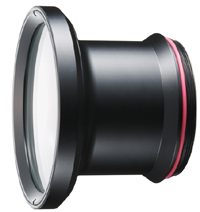 It alone costs more than the entire camera including lens, and that's before you add the underwater housing for the almost always required external flash and the bracketry that holds it all together. If you go to the Olympus Underwater accessories page for the E-620, you'll find that there are no fewer than 20 offerings, for the underwater setup alone. If you gear up, it'll cost $1,449.99 for the bare underwater case, $459.99 for the lens port for our 11-22mm lens, $649 each for the UFL-2 Underwater Strobes (see below), a rather steep $179.99 each for a flash bracket, a stunning $109.99 for the fiber optic cable, and a bunch more for this and that. It adds up and it is a serious commitment. Even a replacement zoom ring is US$89 and a simple lens cap US$29. It alone costs more than the entire camera including lens, and that's before you add the underwater housing for the almost always required external flash and the bracketry that holds it all together. If you go to the Olympus Underwater accessories page for the E-620, you'll find that there are no fewer than 20 offerings, for the underwater setup alone. If you gear up, it'll cost $1,449.99 for the bare underwater case, $459.99 for the lens port for our 11-22mm lens, $649 each for the UFL-2 Underwater Strobes (see below), a rather steep $179.99 each for a flash bracket, a stunning $109.99 for the fiber optic cable, and a bunch more for this and that. It adds up and it is a serious commitment. Even a replacement zoom ring is US$89 and a simple lens cap US$29.
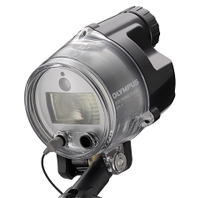 Our test camera came with the housing and two flashes, but no arms or bracketing. I first thought this was an oversight, but Olympus said they concentrate on cameras and lights and now rely on third parties for brackets. I thought this was a bit peculiar because there was a nice base and a variety of rotating arms for earlier Olympus underwater SLRs. There seemed no reason why they would not fit the E-620's housing.
Our test camera came with the housing and two flashes, but no arms or bracketing. I first thought this was an oversight, but Olympus said they concentrate on cameras and lights and now rely on third parties for brackets. I thought this was a bit peculiar because there was a nice base and a variety of rotating arms for earlier Olympus underwater SLRs. There seemed no reason why they would not fit the E-620's housing.
Still, Olympus recommended some third parties and so I went looking there. There's indeed a good selection of brackets, arms, and all sorts of extensions and rotating, pivoting gear. The problem is that it's generally "a la carte," i.e. you have to know what you want and then select and order the parts you want and need. That can take a good bit of research and practical experience. In addition, there are two parts of most underwater bracket systems that I find lacking. The first are the wingnuts/wheels/screws that you use to tighten the joints. Most are difficult to operate and hard to tighten enough, especially underwater. The second are the balls used in the joints. Almost all are plastic with sort of an O-ring insert to provide friction. Problem is that the balls are just too slippery and it's almost impossible to tighten the assembly enough to keep the arms from collapsing, usually in the most inopportune time. A very simple solution would be to use rubber balls instead of the plastic balls. RAM-Mounts makes them for just about anything, except for underwater cameras.
As is, it seemed to make little sense to try to assemble a third party bracket system, especially since we were almost out of time. Olympus no longer had the old base and arms available, but our friends at B&H did! The parts are far from inexpensive, but for once we decided to foot the cost and ordered the old PTBK-E01 Flash Bracket for PFL-E01 and the PTSA-01 Long Arm. B&H delivered within three days, and the bracket and arms work beautifully with the E-620's housing. Case solved (albeit somewhat expensively, for us).
Is it all worth it? For the serious underwater photographer, absolutely. But it is a LOT of money and it is meant for professional quality marine photography. Those who just want to snap some shots will likely be much happier with an inexpensive, small and handy underwater digicam such as the Olympus Tough 8000.
Rather than just admiring the fancy gear, we took the Evolt E-620 and its extensive underwater system on a couple of genuine, heavy-duty dive trips. We spent many hours underwater with it on a total of almost 50 dives and gave it a good workout in a variety of very different dive sites.
We first took it on a week-long live-aboard dive trip onboard the Turks & Caicos Explorer II where we took the camera down to about 120 feet, swam with sharks, and used it in a very wide variety of underwater shooting situations. The second extensive test was during a week of drift diving off the Mexican island of Cozumel.
A lot of gear
If you are new to the world of SLR underwater cases, it's very different from
placing a compact camera into its handy underwater case. There, you just insert the camera and close the case, and you're all set. An SLR case, especially with external flash, is much more involved. Since SLRs come with different lenses, the lens ports for each lens are different. Cables are needed and brackets, and the brackets need to be assembled properly.
There are numerous
O-rings that must be checked for proper sealing, and there are ports that may need
sealer caps if they are not used.
Instead of just closing a case, you really need a checklist, if only a mental one, to make sure you haven't forgotten anything. Even inserting and securing a big SLR into the case is a task that requires practice. There is a ring that operates the zoom lens and it needs to fit just right. There are brackets and supports and control connections that all must be
installed properly or else. The rubber-cushion frame that makes it more
comfortable to look through the viewfinder had to be removed to make the camera fit, and we promptly lost it. And several small parts are also still unaccounted for, though we'll likely find it in our dive gear.
Once you're all set up you have a rather large, bulky, heavy rig, even with the E-620's smaller size. Traveling with it means making triple-sure you don't forget any part of the whole assembly or you can forget about taking underwater pictures. And it needs to be disassembled and stowed away and packed so it won't get damaged, not an easy task with all the parts. We actually got it all into a carry-on, in addition to my dive computer and my regulator, and an assortment of cables and power supplies. Amazingly, the bag made it through the x-ray security machine without raising any questions at all. I wish my sneakers, toiletries and laptop computer were so lucky.
Testing it and impressions
Before our dive trips we took the E-620 rig in the pool to familiarize ourselves with the unit. It was somewhat positively buoyant (that changed later with all the accessories added on). No leaks, no bubbles, no worries. The pool was too shallow to really use the underwater wide or macro, but we did shoot several photos and they all turned out great! There were very few poor quality photos, and that was mostly due to focusing on mid-shot subjects in a macro frame.
Below you can see the full E-620/PT-E06 setup with two UFL-2 strobes.
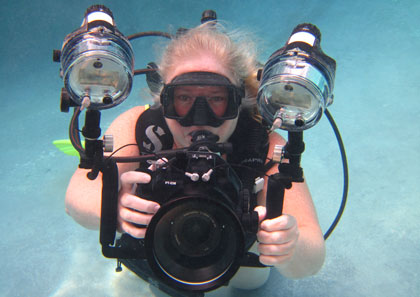
PT-E06 case handling and impressions
Thanks to the reduced size of the E-620, the PT-E06 case is more compact and less bulky compared to the E-330 rig. In all honesty, the case probably needs to be the size it is in order to be not more negatively buoyant as it is. The dome port is large and heavy and adds perceived bulk. It is probably necessary to provide that much space for the wide angle, but there is still a good inch of space between the lens and the glass of the port. The very prominent flare is probably necessary in order not to get vignetting. We wished it'd have been even half an inch shorter as we swam around rocks and through openings. We also felt it must be a nightmare for designers to make all these housings for every new camera, given that the market is not that large.
Below are some notes and observations from during our review process:
- The housing (with the camera in it) has enough positive buoyancy to make it stay on the surface - without strobes and hardware. By adding two strobes the system becomes slightly negative.
- The PT-E06 housing is well built and very sturdy
- Handgrip is comfy, but for larger hands. Turned out to be very comfortable in extended use.
- LOVE the white on black buttons! Very well marked and easy to see.
- Focus ring seems to be a little cumbersome and sloppy, but worked just fine.
- On/Off not clearly marked, and it takes quite an effort to turn it on or off (but that also kept the system from turning on accidentally when brushed up against dive gear, etc.)
- "OK" is in an awkward position, but necessary due to size of buttons.
- Awkward position of Info & Menu button positioning, too. Also due to size. (Also worked fine. It's all a matter of knowing the camera and being familiar with the housing and placement of buttons/toggles.)
- Size of buttons is great for using with cold-water gloves.
- Nice sized screen with hood to block light. Loved it!
- LOVE the red O-rings! They not only add a touch of color, but you can see if they are sitting right!
- While soaking and cleanng the housing after a dive trip, viewfinder barrel fogged up and could not be cleared.
To flash or not to flash
The difference in size and bulk between one of those handy little waterproof compacts (such as the Olympus Tough 8000) and a digital SLR in an underwater housing is huge. Add an external flash or two and the rig becomes large and bulky enough to make demands on diving skills and expertise. One is therefore often tempted to just take the camera on a dive and leave the flash setup with its large and heavy arms and brackets behind. Do not give in to this temptation! Underwater, you need as much light as you can get, and only a good, strong, versatile flash system will yield those colorful underwater shots. Without flash, everything is just greenish and devoid of color.
Compared to standard flash attachments that require their own separate underwater housing, the Olympus UFL-2 underwater strobe is actually quite light and compact. It can handle depths up to 200 feet, has manual and TTL settings, and can be used with either a TTL cable or fiber optic cable. Since the PT-E06 housing only has a single TTL port but two fiber optics ports and we had two external flashes, we used the fiber optic approach. With this method, the camera's onboard flash is popped open inside the underwater housing (there's room). It then flashes at two clear acrylic ports from where the fiber cables trigger the external flashes to fire. This system worked very well and, using the hard-to-find Olympus brackets and arms, the flashes can be turned in all directions thanks to an intricate system of pivots and joints.
In any case, an external flash (or two) is needed. It is the only way to get consistently good pictures underwater, so don't even think about leaving it behind in anything but the clearest shallow tropical water. Unfortunately, that means another set of batteries and another charger to keep track of (the UFL-2 flash uses two standard AAs or recheargeables).
Picture taking
What about pictures? The underwater environment is very different from shooting above ground. You have less time, can see less, have to deal with the bulky scuba equipment, the control buttons on the outside of the housing that go harder and do not offer the same kind of tactile feedback, and, of course, the ever popular low visibility and often unwilling subjects that simply swim away. Given all those caveats and constraints, the E-620 took good pictures right off the bat, in all-automatic mode.
Shooting off a live-aboard in the Turks & Caicos islands in the Caribbean was an ideal venue. The water was quite clear, we didn't encounter any unanticipated surprises, there generally was enough light, and the rig was noticeably handier than the older E-330. There was also plenty to take pictures of, from the gorgeous (but poisonous and invasive) lion fish, to very large moray eels, all sorts of wondrous critters and plants, and even a good number of sharks.
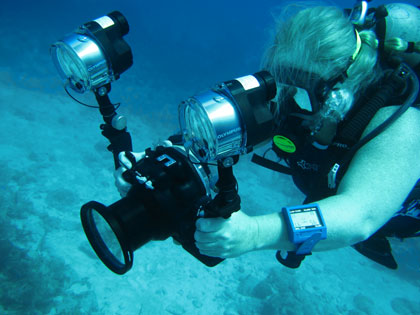
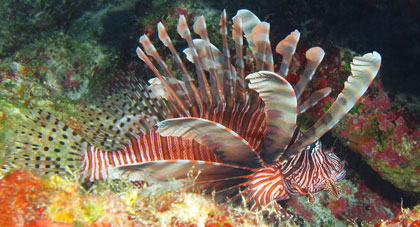
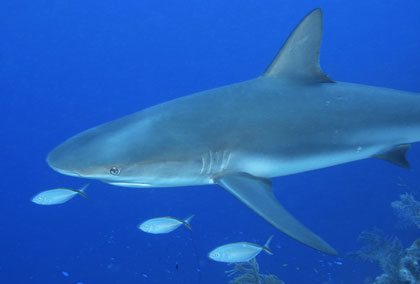
Live preview in action
While no longer an exclusive, one great advantage the E-620 still has over many older underwater SLR cameras is the live preview. That's just a LCD, like all digital cameras have, but underwater, it's often next to impossible to use a viewfinder, what with a mask on, and having the LCD makes a HUGE difference. We never had a problem seeing what we were shooting underwater. We never had to yank the camera up to eye level in front of the mask to take a shot, and thanks to the bright wide viewing angle LCD, we also did not have to move the camera around in order to see the LCD clearly. Another huge advantage.
Diving under different conditions
We ended up taking the E-620 in its housing onto close to 50 dives. This included dives down to 120 feet of depth off West Caicos, night dives, drift dives off Cozumel, numerous swim-throughs and many hours of macro photography on reefs and along walls. We learned to appreciate the comfortable front grooved for four fingers with the thumb resting on a thumb contour on back of the housing. Again, there were hardly any problems, though we did bump into a few little glitches.
For example, we found that while the E-620 isn't a power hog, even its fairly powerful battery only lasted three dives or so. On a live-aboard where you do five dives a day you cannot recharge between dives, so don't go anywhere without one or two spare batteries (they are not expensive). We also bumped into annoying little details like having to remove the housing attachement shoe on the camera to open the battery door. It's almost opens wide enough to get the battery out, but not quite. If you try to force it, the battery compartment door will come off. Not good. Or, it wasn't initially clear how to turn the flash off as the housing did not have a flash button (it's done via menu).
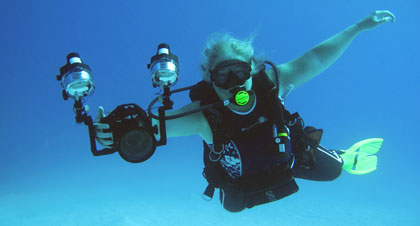
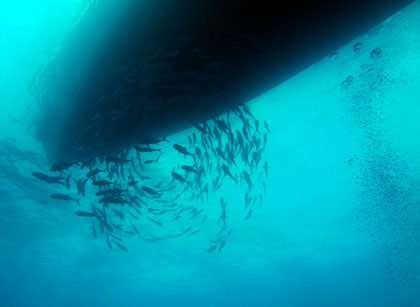
One thing you need to think about is getting the proper lens. Our E-620 package came with two lenses. The 11-22mm Zuiko digital lens was great for underwater where a wide angle always comes in handy. Above water, you generally don't want to go nearly that wide, and we generally used the second lens, a Zuiko Digital 14-42mm. This still doesn't give you much of a zoom, and so you'll likely want to study Olympus' lens offerings (and the underwater lens ports that go with it) in some detail. It's worth it. Above water we often used the very light 40-150mm Zuiko Digital we had from an older Olympus dSLR.
Field notes
Below are some additional entries from our field log. They speak for themselves:
The E-620 works and handles like a dream. With our Olympus brackets it is very well balanced and very handy. Picture quality is great.
A couple of gripes: The tray makes it impossible to open the battery compartment, so you have to remove it each time you change/charge the battery. The battery should be bigger! As is, it was usually out after two dives. That is not enough. The bracket seems to attract salt. It literally accumulates salt crusts even I put into a sweet water rinse tank after each dive.
The E-620 has an underwater mode that is optimized for the special shooting conditions underwater. One thing it does is add red as that is the first color to go when you dive. Problem is, if you forget to switch to another mode close to the surface or after you get out, the pictures will have a red tint. We ended up using the standard shooting modes and that worked just fine.
The 11-22mm wide angle lens was just perfect for underwater shooting. When you dive, it's all too easy to lose a subject because you're rarely still. The wide lens means you have a better chance to get everything into your picture.
The autofocus of the E-620 is lightening-fast! Much faster than in prior Olympus dSLRs.
Picture quality is usually several steps above that of compact camera pics. Compacts also can take very good pictures, but the ratio of good to bad pictures is much, much greater with a camera like the E-620.
Perhaps best, unlike totally dedicated underwater cameras, when we felt like shooting some Caribbean sunsets or Mayan ruins, we could simply take the E-620 out of its housing and use it as a standard SLR, which, of course, it is.
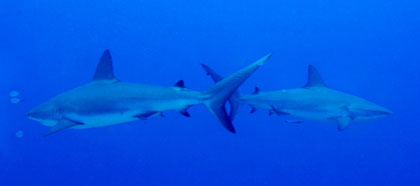
Quality construction
Unlike a lot of economy-priced digital SLRs these days, the Olympus E-620 does not feel cheap, plasticky or toylike. This is a well-built camera that should last for many years.
The PT-E06 underwater housing seems complex enough for things to go wrong, but the case is very well constructed and survived without as much as a scratch. Neither the camera case nor the strobes ever allowed a single drop of water. The many controls all worked well, though a good degree of familiarization comes in handy, especially if you plan on doing more than use just the automatic mode or underwater scene modes. The only thing that went wrong with the housing was that the viewfinder barrel fogged up inside when we soaked the housing after a long week of saltwater diving.
Comitting to a camera like the E-620
One question remains, and it is a serious one. We began this review reminding how quickly digital camera technology advances, and that will not change anytime soon. Spending a lot of money on a setup thus carries a risk as all those professional photographers who spent many thousands on early one and two megapixel digital SLRs will tell.
The risk is somewhat less now as technology has advanced to a point where
it yields incremental rather than dramatic changes and improvements. Unlike the 7.5 megapixel Evolt E-330 that was very quickly eclipsed by smaller and lighter successor models with 10 megapixel resolution that cost less to boot, the 12-megapixel E-620 with live-view will likely hold up better, now that the megapixel arms race has slowed down. However, the latest dSLRs now also shoot high-definition video, something the E-620 cannot do. The camera itself is very reasonably priced, and an investment in Four-Thirds lenses and external strobes is not limited to this camera. The PT-E06 housing, however, is expensive, and it will not fit any other camera, so that ups the decision making ante for those contemplating the entire setup.
The Olympus E-620 itself presents a fortuitous balance of performance, quality and features in a package of modest size and weight. It's a fine deal for those who seek a competent, versatile digital SLR at a very fair price.
We like:
- Competent 12-megapixel digital SLR suitable for above and underwater use
- Very fast autofocus
- �Live View� via bright 2.7-inch wide viewing angle LCD
- LCD can be rotated into different positions (not with housing)
- Compact, high quality underwater housing
- Brackets and pivots allow directing the external flash just right
- Fully automatic settings for beginners yield very good pictures
- Large number of scene modes make for easy picture taking
- Dual card slots (CF and xD)
- Smaller and lighter than predecessors
Not so much:
- Onscreen menus needlessly sparse and cryptic
- physical controls and buttons scattered
- No video or audio
- Underwater assembly with flash is still large, negatively buoyant, and has small parts that can get lost.
- Viewfinder barrel in housing fogged up during after-dive soaking
- When in housing, turning camera flash on and off via menu cumbersome.
|
